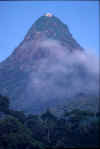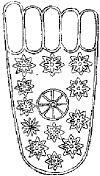|
|
the-south-asian.com January 2003 |
||||
|
JANUARY 2003 Contents Swami
Agnivesh & Music Ustad
Amjad Ali Khan Heritage
Books 'India
in Slow Motion' Serialisation
of 'Knock at every alien Events South Asian
Events in Lehngas - a limited collection Books
|
|
||||
|
Page 1 of 2
Sri Pada & Kataragama – Sri Lanka's symbols of inter-faith harmony by Rajika Jayatilake
Sri Lanka is a country that thrives on religious harmony. This seems an ironic statement about a country that has seen over twenty years of gruesome bloodletting by one of the most ruthless of terrorist groups in the world. Tolerance would be the most scarce commodity around, or so you would think. Yet, when you step onto serendipity, you must expect to make wonderful discoveries. And what do you find? A Buddhist country where Hinduism, Christianity and Islam co-exist in complete harmony. Thus, when we speak of Sri Lanka, it is always in the context of a multi-ethnic, multi-religious and multi-cultural social fabric. Sri Pada is known as the only mountain in the world considered sacred by the followers of the four major faiths in the world – Buddhists, Hindus, Christians and Muslims. To Buddhists, the imprint at the summit of the mountain is the hallowed footprint of the Buddha, hence the name "Sri Pada". To the Hindus, the footprint is that of God Shiva. To the Christians, it is the footprint of St. Thomas, and to Muslims, it is the foot print of Adam, hence "Adam’s Peak". Another name for the mountain by the Sinhalese is "Samanala Kanda" meaning Butterfly Mountain due to the endless flocks of butterflies that wing their way to the mountain with the start of the season.
Sri Pada
Sri Pada is known as the only mountain in the world considered sacred by the followers of the four major faiths in the world – Buddhists, Hindus, Christians and Muslims. To Buddhists, the imprint at the summit of the mountain is the hallowed footprint of the Buddha, hence the name "Sri Pada". To the Hindus, the footprint is that of God Shiva. To the Christians, it is the footprint of St. Thomas, and to Muslims, it is the foot print of Adam, hence "Adam’s Peak". Another name for the mountain by the Sinhalese is "Samanala Kanda" meaning Butterfly Mountain due to the endless flocks of butterflies that wing their way to the mountain with the start of the season. The Sri Pada pilgrimage is punctuated with tradition. It is customary for first time climbers to bathe at the stream call "Seetha Gangula" and to pile white cloth on their heads. At "indikatu pana" (place of the needle), pilgrims stop to hang a threaded needle on a shrub on the wayside, marking a spot where the Buddha is said to have stopped to mend a tear in his robe. It is taboo to talk about how long it takes to climb to the top. When pilgrims meet, they always exchange greetings "karunawai" - "peace". Some groups of pilgrims reduce the monotony of the climb by singing folk songs. Every pilgrim is expected to toll the huge bell at the summit - once for each time they visited. As the deep and solemn peals resonate, the pilgrims become ecstatic According to the Mahavamsa, the Great Chronicle of the Island, the first person to ascend the holy mountain Sri Pada, was king Vijayabahu I (1058-1114), having come to know that atop the mountain is seen the footmark of the Buddha. The story goes he had gathered the information from the pious woman Manimekhala. A more colourful story is that the king had seen, in the early hours of one morning, angels plucking flowers in his garden. When questioned, one of them had said "We are plucking flowers to worship the footmark of the Buddha atop the Samanalakanda." The sacred foot print that Dr. John Davy
saw in 1817, was ornamented The ‘Cetiya’ situated at the foot of Sri Pada is the peace pagoda erected by the Japanese Buddhists to spread the message of peace throughout the world from which begins the arduous climb to the summit of the Adams peak. History records that many distinguished
persons like Ibn Batuta, the Arab traveler, and Marco Polo, have climbed Sri
Pada . Kataragama Another place where religious tolerance can be seen at its best, is at Kataragama, a unique Murukan temple in Sri Lanka, located in the deep south, its cultural origin buried in ancient history. It is a place where all ethnic groups, religions and cultures meet in deepest respect to one another and in complete harmony. The Hindus, the Buddhists, the Muslims and the Veddahs all claim to preserve the "original" traditions of Kataragama. Even during the times of strife and conflict in other parts of the country, Kataragama preserves racial and religious harmony.
|
|||||
| Copyright © 2000 - 2003 [the-south-asian.com]. Intellectual Property. All rights reserved. | |||||
| Home | |||||



